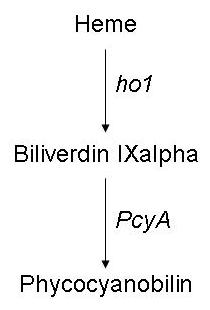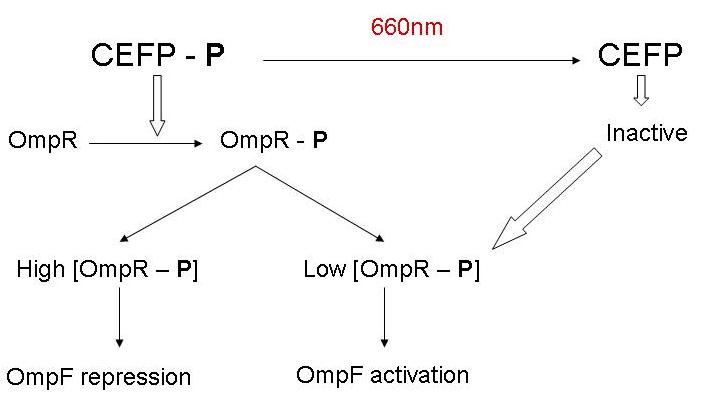Team:KULeuven/Project/Input
From 2008.igem.org
Contents |
Input
Searching for an input signal that was easily turned on and off, we chose to use the light-sensing device [http://partsregistry.org/Part:BBa_M30109 BBa_M30109]. This device has already been used by a number of teams, but for the sake of completeness, we describe it here again. We also gave it our own (working) number: [http://partsregistry.org/Part:BBa_K145011 BBa_K145011].
BioBricks
Components
The first step is to produce ho1 (heme oxigenase 1) that converts heme to biliverdin IXalpha. This enzyme is encoded by [http://partsregistry.org/Part:BBa_I15008 BBa_I15008]. The second step is to produce PcyA (phycocyanobilin:ferredoxin oxidoreductase) that converts the biliverdin IXalpha to phycocyanobilin. This enzyme is encoded by [http://partsregistry.org/Part:BBa_I15009 BBa_I15009]. This phycocyanobilin associates with the light receptive domain Cph1 of a Cph1/EnvZ fusion protein, encoded by [http://partsregistry.org/Part:BBa_I15010 BBa_I15010].
An extra need for the input mechanism is the presence of the TetR repressor. This molecule is encoded by part [http://partsregistry.org/Part:BBa_C0040 BBa_C0040], and contains an LVA tag for rapid degradation.
Action
The ho1 and PcyA coding parts are placed under a Pbad promoter ([http://partsregistry.org/Part:BBa_I13453 BBa_I13453]). As the AraC repressor is present in the cell, phycocyanobilin will only be made upon activation with arabinose. The coding part for the Cph1/EnvZ fusion protein is placed under control of a pTet promoter ([http://partsregistry.org/Part:BBa_R0040 BBa_R0040]). This means that, as TetR ([http://partsregistry.org/Part:BBa_C0040 BBa_C0040]), the Tet repressor, is present, the fusion protein will only be produced when aTc is added to the medium. This gives us the possibility to test the system with an exogenous memory instead of the endogenous one, which will then be added later on in the project (see here).
 "
"





 Input
Input Output
Output Filter
Filter InverTimer
InverTimer Reset
Reset Cell Death
Cell Death Memory
Memory